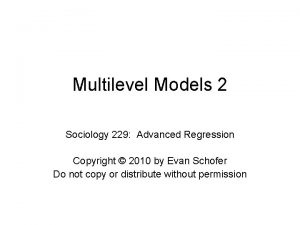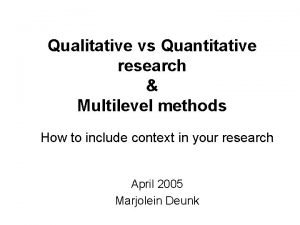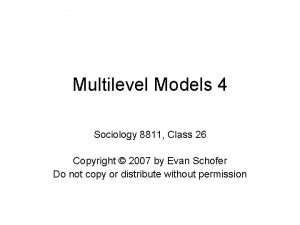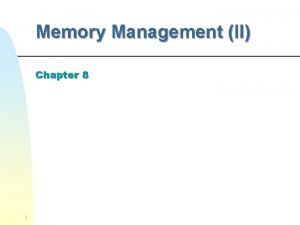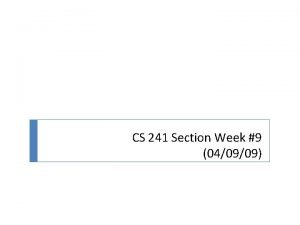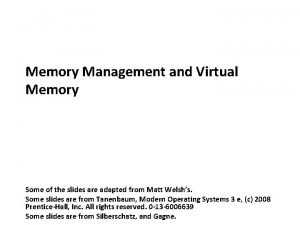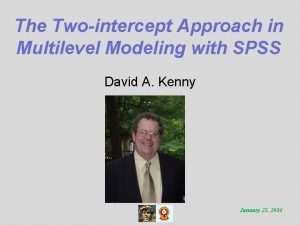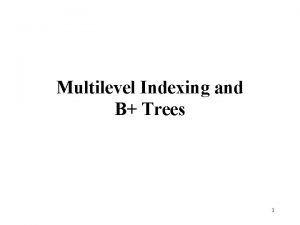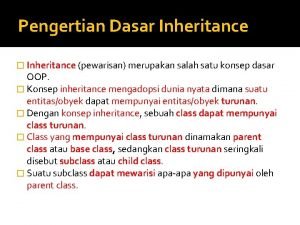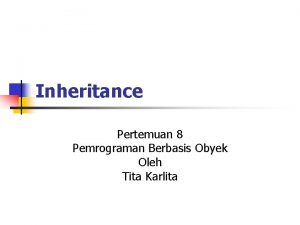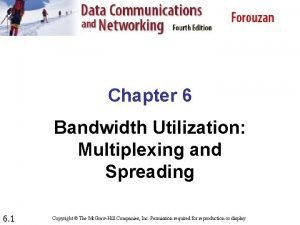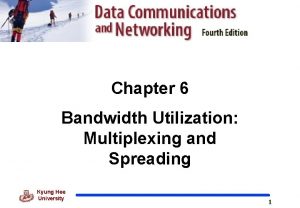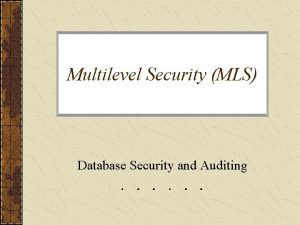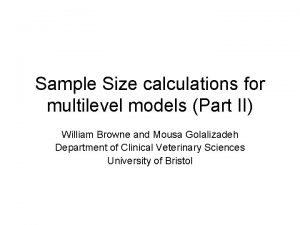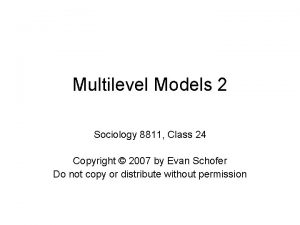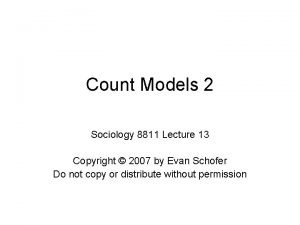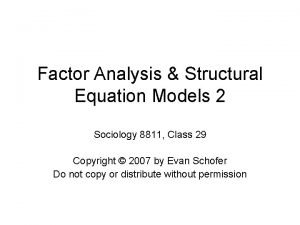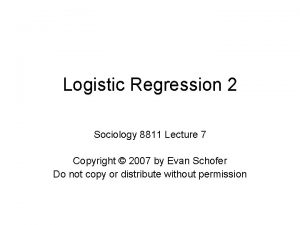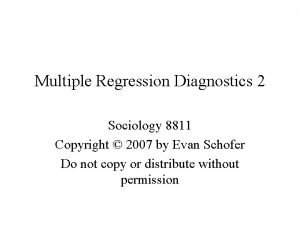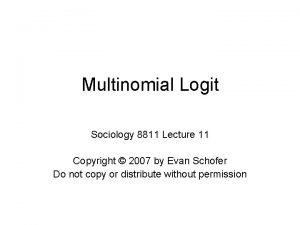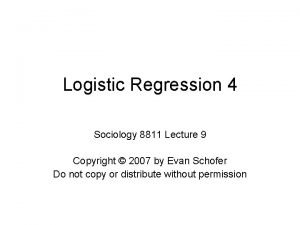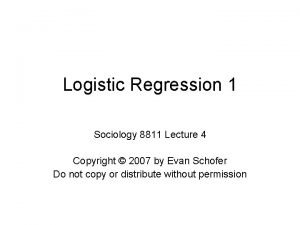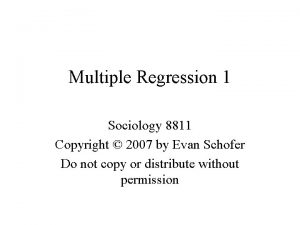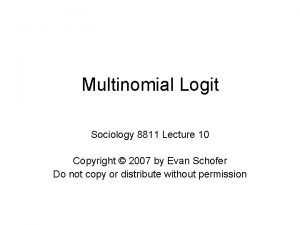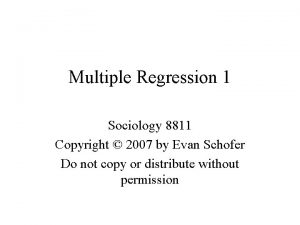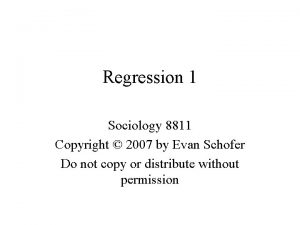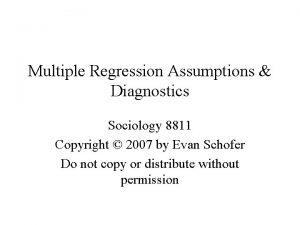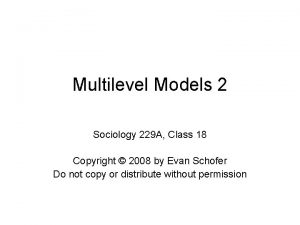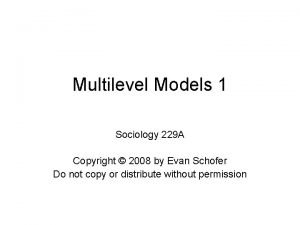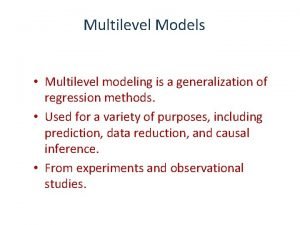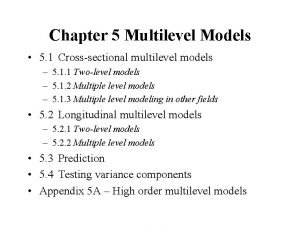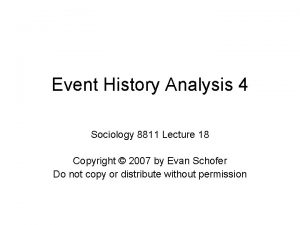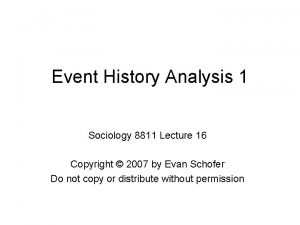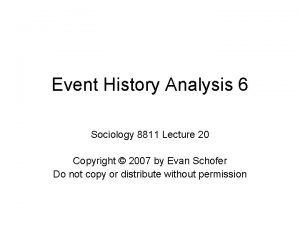Multilevel Models 3 Sociology 8811 Class 25 Copyright































- Slides: 31

Multilevel Models 3 Sociology 8811, Class 25 Copyright © 2007 by Evan Schofer Do not copy or distribute without permission

Announcements • Paper #2 due April 26 • Come see me ASAP if you don’t have a plan – Class topic: More multilevel models

Paper #1 Comments • Papers were very good overall! • Main issues: – 1. A few people didn’t devote much time to diagnostics… they are important! – 2. Some issues with models… choice of variables needs to be thought through – 3. Some issues with focus / attention • Don’t spend 2 pages describing the histogram of each and every variable • Prioritize! Focus on interesting / important things – Ex: spend more time on problematic diagnostics, less on unimportant detail

Paper #1 Comments • Main issues: – 4. Avoid obviously useless plots/diagrams/info • Ex: useless scatterplots of nominal/ordinal variables (without jitter) – 5. Avoid over-strong / absolute language • “There were no standardized residuals over 3, so I was able to determine that there were no outliers. ” – First, standardized residuals is not the best way to diagnose outliers. Cooks D and other statistics help paint a full picture. – Second, (and more importantly): conclusion is too strong – Better to say: Examination of standardized residuals, cooks D, and scatterplots found no indication of influential cases.

Fixed Effects Model (FEM) • Fixed effects model: • For i cases within j groups • Therefore aj is a separate intercept for each group • It is equivalent to solely at within-group variation: • X-bar-sub-j is mean of X for group j, etc • Model is “within group” because all variables are centered around mean of each group.

Random Effects • Issue: The dummy variable approach (ANOVA, FEM) treats group differences as a fixed effect • Alternatively, we can treat it as a random effect • Don’t estimate values for each case, but model it • This requires making assumptions – e. g. , that group differences are normally distributed with a standard deviation that can be estimated from data.

Random Effects • A simple random intercept model – Notation from Rabe-Hesketh & Skrondal 2005, p. 4 -5 Random Intercept Model • Where b is the main intercept • u is a random effect for each group – Allowing each of j groups to have its own intercept – Assumed to be independent & normally distributed • Error (e) is the error term for each case – Also assumed to be independent & normally distributed • Note: Other texts refer to random intercepts as uj or nj.

Linear Random Intercepts Model • The random intercept idea can be applied to linear regression • • Often called a “random effects” model… Result is similar to FEM, BUT: FEM looks only at within group effects Aggregate models (“between effects”) looks across groups – Random effects models yield a weighted average of between & within group effects • It exploits between & within information, and thus can be more efficient than FEM & aggregate models. – IF distributional assumptions are correct.

Linear Random Intercepts Model. xtreg supportenv age male dmar demp educ incomerel ses, i(country) re Random-effects GLS regression Group variable (i): country R-sq: within = 0. 0220 between = 0. 0371 overall = 0. 0240 Random effects u_i ~ Gaussian corr(u_i, X) = 0 (assumed) Assumes normal uj, uncorrelated with X vars Number of obs Number of groups = = 27807 26 Obs per group: min = avg = max = 511 1069. 5 2154 Wald chi 2(7) Prob > chi 2 625. 50 0. 0000 = = ---------------------------------------supportenv | Coef. Std. Err. z P>|z| [95% Conf. Interval] -------+--------------------------------age | -. 0038709. 0008152 -4. 75 0. 000 -. 0054688 -. 0022731 male |. 0978732. 0229632 4. 26 0. 000. 0528661. 1428802 dmar |. 0030441. 0252075 0. 12 0. 904 -. 0463618. 05245 demp | -. 0737466. 0252831 -2. 92 0. 004 -. 1233007 -. 0241926 educ |. 0857407. 0061501 13. 94 0. 000. 0736867. 0977947 incomerel |. 0090308. 0059314 1. 52 0. 128 -. 0025945. 0206561 ses |. 131528. 0134248 9. 80 0. 000. 1052158. 1578402 _cons | 5. 924611. 1287468 46. 02 0. 000 5. 672272 6. 17695 -------+--------------------------------sigma_u |. 59876138 SD of u (intercepts); SD of e; intra-class correlation sigma_e | 1. 8701896 rho |. 09297293 (fraction of variance due to u_i)

Linear Random Intercepts Model • Notes: Model can also be estimated with maximum likelihood estimation (MLE) • Stata: xtreg y x 1 x 2 x 3, i(groupid) mle – Versus “re”, which specifies weighted least squares estimator • Results tend to be similar • But, MLE results include a formal test to see whether intercepts really vary across groups – Significant p-value indicates that intercepts vary. xtreg supportenv age male dmar demp educ incomerel ses, i(country) mle Random-effects ML regression Number of obs = 27807 Group variable (i): country Number of groups = 26 … MODEL RESULTS OMITTED … /sigma_u |. 5397755. 0758087. 4098891. 7108206 /sigma_e | 1. 869954. 0079331 1. 85447 1. 885568 rho |. 0769142. 019952. 0448349. 1240176 ---------------------------------------Likelihood-ratio test of sigma_u=0: chibar 2(01)= 2128. 07 Prob>=chibar 2 = 0. 000

Choosing Models • Which model is best? • There is much discussion (e. g, Halaby 2004) • Fixed effects are most consistent under a wide range of circumstances • Consistent: Estimates approach true parameter values as N grows very large • But, they are less efficient than random effects – In cases with low within-group variation (big between group variation) and small sample size, results can be very poor – Random Effects = more efficient • But, runs into problems if specification is poor – Esp. if X variables correlate with random group effects – Usually due to omitted variables.

Hausman Specification Test • Hausman Specification Test: A tool to help evaluate fit of fixed vs. random effects • Logic: Both fixed & random effects models are consistent if models are properly specified • However, some model violations cause random effects models to be inconsistent – Ex: if X variables are correlated to random error • In short: Models should give the same results… If not, random effects may be biased – If results are similar, use the most efficient model: random effects – If results diverge, odds are that the random effects model is biased. In that case use fixed effects…

Hausman Specification Test • Strategy: Estimate both fixed & random effects models • Save the estimates each time • Finally invoke Hausman test – Ex: • • • streg var 1 var 2 var 3, i(groupid) fe estimates store fixed streg var 1 var 2 var 3, i(groupid) re estimates store random hausman fixed random

Hausman Specification Test • Example: Environmental attitudes fe vs re. hausman fixed random Direct comparison of coefficients… ---- Coefficients ---| (b) (B) (b-B) sqrt(diag(V_b-V_B)) | fixed random Difference S. E. -------+--------------------------------age | -. 0038917 -. 0038709 -. 0000207. 0000297 male |. 0979514. 0978732. 0000783. 0004277 dmar |. 0024493. 0030441 -. 0005948. 0007222 demp | -. 0733992 -. 0737466. 0003475. 0007303 educ |. 0856092. 0857407 -. 0001314. 0002993 incomerel |. 0088841. 0090308 -. 0001467. 0002885 ses |. 1318295. 131528. 0003015. 0004153 ---------------------------------------b = consistent under Ho and Ha; obtained from xtreg B = inconsistent under Ha, efficient under Ho; obtained from xtreg Test: Ho: difference in coefficients not systematic chi 2(7) = (b-B)'[(V_b-V_B)^(-1)](b-B) = 2. 70 Prob>chi 2 = 0. 9116 Non-significant pvalue indicates that models yield similar results…

Within & Between Effects • What is the relationship between within-group effects (FEM) and between-effects (BEM)? • • Usually they are similar Ex: Student skills & test performance Within any classroom, skilled students do best on tests Between classrooms, classes with more skilled students have higher mean test scores.

Within & Between Effects • Issue: Between and within effects can differ! • Ex: Effects of wealth on attitudes toward welfare • At the individual level (within group) – Wealthier people are conservative, don’t support welfare • At the country level (between groups): – Wealthier countries (high aggregate mean) tend to have prowelfare attitudes (ex: Scandinavia) • Result: Wealth has opposite between vs within effects! – Issue: Such dynamics often result from omitted level-1 variables (omitted variable bias) • Ex: If we control for individual “political conservatism”, effects may be consistent at both levels…

Within & Between Effects • You can estimate BOTH within- and betweengroup effects in a single model • Strategy: Split a variable (e. g. , SES) into two new variables… – 1. Group mean SES – 2. Within-group deviation from mean SES » Often called “group mean centering” • Then, put both variables into a random effects model • Model will estimate separate coefficients for between vs. within effects – Ex: • egen meanvar 1 = mean(var 1), by(groupid) • egen withinvar 1 = var 1 – meanvar 1 • Include mean (aggregate) & within variable in model.

Within & Between Effects • Example: Pro-environmental attitudes. xtreg supportenv meanage withinage male dmar demp educ incomerel ses, i(country) mle Random-effects ML regression Group variable (i): country Random effects ~ Gaussian Between & withinu_i effects are opposite. Older countries are MORE environmental, but older people are LESS. Omitted variables? Wealthy European countries Log strong likelihood -56918. 299 with green =parties have older populations! Number of obs Number of groups = = 27807 26 Obs per group: min = avg = max = 511 1069. 5 2154 LR chi 2(8) Prob > chi 2 620. 41 0. 0000 = = ---------------------------------------supportenv | Coef. Std. Err. z P>|z| [95% Conf. Interval] -------+--------------------------------meanage |. 0268506. 0239453 1. 12 0. 262 -. 0200812. 0737825 withinage | -. 003903. 0008156 -4. 79 0. 000 -. 0055016 -. 0023044 male |. 0981351. 0229623 4. 27 0. 000. 0531299. 1431403 dmar |. 003459. 0252057 0. 14 0. 891 -. 0459432. 0528612 demp | -. 0740394. 02528 -2. 93 0. 003 -. 1235873 -. 0244914 educ |. 0856712. 0061483 13. 93 0. 000. 0736207. 0977216 incomerel |. 008957. 0059298 1. 51 0. 131 -. 0026651. 0205792 ses |. 131454. 0134228 9. 79 0. 000. 1051458. 1577622 _cons | 4. 687526. 9703564 4. 83 0. 000 2. 785662 6. 58939

Within & Between Effects / Centering • Multilevel models & “centering” variables • Grand mean centering: computing variables as deviations from overall mean • Often done to X variables • Has effect that baseline constant in model reflects mean of all cases – Useful for interpretation • Group mean centering: computing variables as deviation from group mean • Useful for decomposing within vs. between effects • Often in conjunction with aggregate group mean vars.

Generalizing: Random Coefficients • Linear random intercept model allows random variation in intercept (mean) for groups • But, the same idea can be applied to other coefficients • That is, slope coefficients can ALSO be random! Random Coefficient Model Which can be written as: • Where zeta-1 is a random intercept component • Zeta-2 is a random slope component.

Linear Random Coefficient Model Both intercepts and slopes vary randomly across j groups Rabe-Hesketh & Skrondal 2004, p. 63

Random Coefficients Summary • Some things to remember: • Dummy variables allow fixed estimates of intercepts across groups • Interactions allow fixed estimates of slopes across groups • Random coefficients allow intercepts and/or slopes to vary across groups randomly! – The model does not directly estimate those effects, just as a model does not estimate coefficients for each case residual – BUT, random components can be predicted after the fact (just as you can compute residuals – random error).

STATA Notes: xtreg, xtmixed • xtreg – allows estimation of between, within (fixed), and random intercept models • • xtreg y x 1 x 2 x 3, i(groupid) fe - fixed (within) model xtreg y x 1 x 2 x 3, i(groupid) be - between model xtreg y x 1 x 2 x 3, i(groupid) re - random intercept (GLS) xtreg y x 1 x 2 x 3, i(groupid) mle - random intercept (MLE) • xtmixed – allows random slopes & coefs • “Mixed” models refer to models that have both fixed and random components • xtmixed [depvar] [fixed equation] || [random eq], options • Ex: xtmixed y x 1 x 2 x 3 || groupid: x 2 – Random intercept is assumed. Random coef for X 2 specified.

STATA Notes: xtreg, xtmixed • Random intercepts • xtreg y x 1 x 2 x 3, i(groupid) mle – Is equivalent to • xtmixed y x 1 x 2 x 3 || groupid: , mle • xtmixed assumes random intercept – even if no other random effects are specified after “groupid” – But, we can add random coefficients for all Xs: • xtmixed y x 1 x 2 x 3 || groupid: x 1 x 2 x 3 , mle – Note: xtmixed can do a lot… but GLLAMM can do even more! • “General linear & latent mixed models” • Must be downloaded into stata. Type “search gllamm” and follow instructions to install…

Random intercepts: xtmixed • Example: Pro-environmental attitudes. xtmixed supportenv age male dmar demp educ incomerel ses || country: , mle Mixed-effects ML regression Group variable: country Wald chi 2(7) = 625. 75 Log likelihood = -56919. 098 Number of obs Number of groups = = 27807 26 Obs per group: min = avg = max = 511 1069. 5 2154 Prob > chi 2 0. 0000 = ---------------------------------------supportenv | Coef. Std. Err. z P>|z| [95% Conf. Interval] -------+--------------------------------age | -. 0038662. 0008151 -4. 74 0. 000 -. 0054638 -. 0022687 male |. 0978558. 0229613 4. 26 0. 000. 0528524. 1428592 dmar |. 0031799. 0252041 0. 13 0. 900 -. 0462193. 0525791 demp | -. 0738261. 0252797 -2. 92 0. 003 -. 1233734 -. 0242788 educ |. 0857707. 0061482 13. 95 0. 000. 0737204. 097821 incomerel |. 0090639. 0059295 1. 53 0. 126 -. 0025578. 0206856 ses |. 1314591. 0134228 9. 79 0. 000. 1051509. 1577674 _cons | 5. 924237. 118294 50. 08 0. 000 5. 692385 6. 156089 ---------------------------------------[remainder of output cut off] Note: xtmixed yields identical results to xtreg , mle

Random intercepts: xtmixed • Ex: Pro-environmental attitudes (cont’d) supportenv | Coef. Std. Err. z P>|z| [95% Conf. Interval] -------+--------------------------------age | -. 0038662. 0008151 -4. 74 0. 000 -. 0054638 -. 0022687 male |. 0978558. 0229613 4. 26 0. 000. 0528524. 1428592 dmar |. 0031799. 0252041 0. 13 0. 900 -. 0462193. 0525791 demp | -. 0738261. 0252797 -2. 92 0. 003 -. 1233734 -. 0242788 educ |. 0857707. 0061482 13. 95 0. 000. 0737204. 097821 incomerel |. 0090639. 0059295 1. 53 0. 126 -. 0025578. 0206856 ses |. 1314591. 0134228 9. 79 0. 000. 1051509. 1577674 _cons | 5. 924237. 118294 50. 08 0. 000 5. 692385 6. 156089 -----------------------------------------------------------------------------Random-effects Parameters | Estimate Std. Err. [95% Conf. Interval] ---------------+------------------------country: Identity | sd(_cons) |. 5397758. 0758083. 4098899. 7108199 ---------------+------------------------sd(Residual) | 1. 869954. 0079331 1. 85447 1. 885568 ---------------------------------------LR test vs. linear regression: chibar 2(01) = 2128. 07 Prob >= chibar 2 = 0. 0000 xtmixed output puts all random effects below main coefficients. Here, they are “cons” (constant) for groups defined by “country”, plus residual (e) Non-zero SD indicates that intercepts vary

Random Coefficients: xtmixed • Ex: Pro-environmental attitudes (cont’d). xtmixed supportenv age male dmar demp educ incomerel ses || country: educ, mle [output omitted] supportenv | Coef. Std. Err. z P>|z| [95% Conf. Interval] -------+--------------------------------age | -. 0035122. 0008185 -4. 29 0. 000 -. 0051164 -. 001908 male |. 1003692. 0229663 4. 37 0. 000. 0553561. 1453824 dmar |. 0001061. 0252275 0. 00 0. 997 -. 0493388. 049551 demp | -. 0722059. 0253888 -2. 84 0. 004 -. 121967 -. 0224447 educ |. 081586. 0115479 7. 07 0. 000. 0589526. 1042194 incomerel |. 008965. 0060119 1. 49 0. 136 -. 0028181. 0207481 ses |. 1311944. 0134708 9. 74 0. 000. 1047922. 1575966 _cons | 5. 931294. 132838 44. 65 0. 000 5. 670936 6. 191652 ---------------------------------------Random-effects Parameters | Estimate Std. Err. [95% Conf. Interval] ---------------+------------------------country: Independent | sd(educ) |. 0484399. 0087254. 0340312. 0689492 sd(_cons) |. 6179026. 0898918. 4646097. 821773 ---------------+------------------------sd(Residual) | 1. 86651. 0079227 1. 851046 1. 882102 ---------------------------------------LR test vs. linear regression: chi 2(2) = 2187. 33 Prob > chi 2 = 0. 0000 Here, we have allowed the slope of educ to vary randomly across countries Educ (slope) varies, too!

Random Coefficients: xtmixed • What are random coefficients doing? • Let’s look at results from a simplified model – Only random slope & intercept for education Model fits a different slope & intercept for each group!

Random Coefficients • Why bother with random coefficients? • 1. A solution for clustering (non-independence) – Usually people just use random intercepts, but slopes may be an issue also • 2. You can create a better-fitting model – If slopes & intercepts vary, a random coefficient model may fit better – Assuming distributional assumptions are met – Model fit compared to OLS can be tested…. • 3. Better predictions – Attention to group-specific random effects can yield better predictions (e. g. , slopes) for each group » Rather than just looking at “average” slope for all groups • 4. Helps us think about multilevel data » Ex: cross-level interactions (we’ll discuss soon!)

Multilevel Model Notation • So far, we have expressed random effects in a single equation: Random Coefficient Model • However, it is common to separate the fixed and random parts into multiple equations: Just a basic OLS model… Intercept equation Slope Equation But, intercept & slope are each specified separately as having a random component

Multilevel Model Notation • The “separate equation” formulation is no different from what we did before… • But it is a vivid & clear way to present your models • All random components are obvious because they are stated in separate equations • NOTE: Some software (e. g. , HLM) requires this – Rules: • 1. Specify an OLS model, just like normal • 2. Consider which OLS coefficients should have a random component – These could be the intercept or any X variable (slope) • 3. Specify an additional formula for each random coefficient.
 Advanced regression and multilevel models
Advanced regression and multilevel models What are multilevel security models?
What are multilevel security models? What is the difference between semi modals and modals?
What is the difference between semi modals and modals? Multi level page table
Multi level page table Teaching multilevel esl classes
Teaching multilevel esl classes What is multilevel feedback queue scheduling
What is multilevel feedback queue scheduling Multilevel model equation example
Multilevel model equation example Multilevel model equation example
Multilevel model equation example Multilevel paging in os
Multilevel paging in os Multilevel bus architecture
Multilevel bus architecture Multilevel page tables
Multilevel page tables Process virtual address space
Process virtual address space Multilevel modeling in spss
Multilevel modeling in spss Priority scheduling in os
Priority scheduling in os Multilevel indexing
Multilevel indexing Miller indices visualizer
Miller indices visualizer Multilevel nand gate
Multilevel nand gate Apa yang dimaksud inheritance
Apa yang dimaksud inheritance Multi level instruction
Multi level instruction Contoh multilevel inheritance
Contoh multilevel inheritance Distinguish between synchronous and statistical tdm.
Distinguish between synchronous and statistical tdm. Multilevel instruction
Multilevel instruction Multilevel scheme in data communication
Multilevel scheme in data communication Multilevel multiplexing
Multilevel multiplexing Multilevel database security
Multilevel database security Sjf cpu scheduling
Sjf cpu scheduling Sample size calculations in multilevel modelling
Sample size calculations in multilevel modelling Have a class today
Have a class today Putting a package together
Putting a package together Difference between abstract class and concrete class
Difference between abstract class and concrete class Mode of grouped data
Mode of grouped data Class i vs class ii mhc
Class i vs class ii mhc
